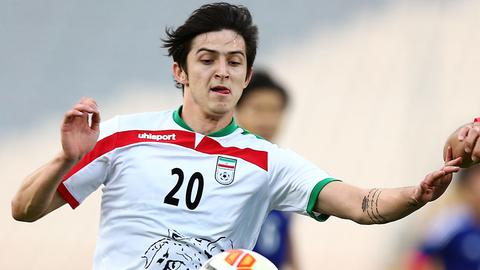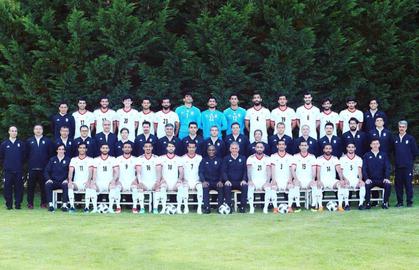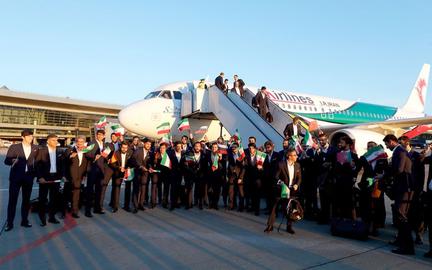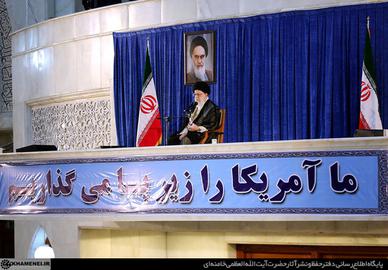Carlos Queiroz, the head coach of Iran’s National Football Team, and his team of 23 Iranian footballers have arrived in Russia for the 2018 FIFA World Cup. Iranians around the world are hoping the team will do wonders in what promises to be the toughest competitive line-up in the history of Iranian football. So who are the 23 footballers playing for Team Melli?
Alireza Biranvand
Goalkeeper
Alireza Biranvand’s real birthdate is shrouded in mystery, but his ID says that he was born in 1992. Eight years ago, he joined the Naft Tehran football team and since 2016 he has been wearing a Persepolis jersey. Playing for both Iran’s National Under-20s and Under-23s teams and now for the adult team has made him a number one man to watch in Iranian football. At almost 6’4 (195cm), his height sets him apart, as do his extraordinary throws and his confident exits, although he has always been rather unsteady when it comes to one-to-ones and kicks from behind the 18-yard line.
Mohammad Rashid Mazaheri
Goalkeeper
This young man of Iranian football started at Khuzestan’s Esteghlal team, then joined Foolad. He currently plays for Zob Ahan. Over the last four years, his talent and strength as a goalkeeper have gained him much praise, and his important role in Zob Ahan’s success over the last three years cannot be denied. Born in 1989 and standing at 6’2 (191cm), he is distinguished by his ability to tackle penalty kicks.
Amir Abedzadeh
Goalkeeper
Amir Abedzadeh is the son of the former national team goalkeeper Ahmad Reza Abedzadeh. He joined the national team when he was 25. He once said he wanted to break the unwritten rule that “footballers’ sons can never equal their fathers.” However, he probably knows that the three current goalkeepers for the national team added together do not equal his father’s skill and talent. He has played for the US team LA Blues, for Iranian teams Persepolis and Rah Ahan, and for the Portuguese teams Barreirense and Marítimo, for which he currently plays. People close to Queiroz say the coach is thinking about using him in the main lineup for Iran’s national team.
Milad Mohammadi
Defender
Mohammadi is calm, silent and shy. But his power should not be underestimated — Son Heung-min, the South Korean forward, said of him: “I had never come across such a wall.” In fact, he has been described as the best left winger of today’s Asian football. Early in his career he played for Persepolis, then leaving to play for Rah Ahan, and currently he plays for the Russian team Akhmat Grozny. Aged 24, he is one of Iranian football’s top talents. During the World Cup, fans will count on both his speed and his extraordinary intelligence.
Mohammad Reza Khanzadeh
Defender
Khanzadeh also goes by the nickname “Son of Carlos,” and, undoubtedly, he is one of Carlos Queiroz’s favorite players. He has played for Rah Ahan, Persepolis, Zob Ahan, Foolad, Siah Jamegan and in the current season plays for Padideh. He has played for Iran’s national team at every age level. He was invited to play for the national team in 2012, but has so far only played eight games.
Morteza Pouraliganji
Defender
When looking at Iran’s center-field defense, Morteza Pouraliganji stands out, considered the most important player at the heart of Iran’s defensive line. He was born in 1992 and has played for Tehran’s Naft, China’s Tianjin and Qatar’s Al Sadd teams. He, like Khanzadeh, also played for Iran’s Under 17s, Under 23s and Under 20s teams. He has played 25 games for Iran’s national team and has two goals to his name. Pouraliganji is Carlos Queiroz’s first hope to hold Iran’s centerfield defense.
Ramin Rezaian
Defender
Known as Queiroz’s favorite right winger, Rezaian has had a difficult year and so has not been spoken of with the same amount of confidence he once was. He currently plays for the Belgian team Oostende, and has played for Iranian teams Saba, Rah Ahan and Persepolis. In the national team, he has played 24 games and scored two goals. Unless Queiroz makes an unexpected change, Rezaian will play on the right side of the Iranian defense line during the World Cup.
Pejman Montazeri
Defender
Born in 1983, Montazeri is the oldest player in Iran’s National Football Team. If Queiroz does decide to take Rezaian out of the defensive line-up, he might replace him with Montazeri. During the last World Cup in Brazil, the head coach did use him as a right winger, and deployed him at the midfield playing defensive halfback during Iran’s game against Uzbekistan. Montazeri has played for Foolad, Esteghlal and Qatar’s Umm-Salal and Al-Ahli teams. He has played in 41 games for the national team and has scored two goals.
Majid Hosseini
Defender
Hosseini, born in 1996, is the national team’s least experienced defender. But he is currently one of the best defenders in the upper Iranian league and was one of the two main defenders for the Esteghlal football team. Whether Queiroz will choose to deploy him at the World Cup remains to be seen.
Rouzbeh Cheshmi
Defender
Chesmi is a regarded as a faithful, reliable footballer. Born in 1993, he has played for only two Iranian upper league teams — Saba and Esteghlal — but he advanced steadily through each of the youth categories at the national level. He has gained experience as a midfielder, but both Winfried Schäfer, the manager of Esteghlal, and Carlos Queiroz have used him in the center defense line. He was criticized extensively after his performance in the May friendly against Turkey — which Iran lost — but Queiroz stood by him.
Ehsan Hajsafi
Midfielder and Captain
The star of Isfahan’s Sepahan team in 2006 is now one of three captains for Iran’s National Football Team. He was known as an offensive half-back when he played for Iran’s football league but Queiroz has deployed him in all left positions — left defense, offensive half-back and now middle half-back. Hajsafi was born in 1990 and has played for Sepahan, Tractor Sazi, FSV Frankfurt and the Greek teams Panionios and Olympiacos. In August 2017, Hajsafi and another Iranian player for Panionios, Masoud Shojaei, came under fire for defying a ban on competing with Israeli athletes by playing against Maccabi Tel Aviv and faced temporary suspension.
Besides having played at all age groups, Hajsafi has played 89 times for the national team and has scored six goals. He is considered one of the most effective of Queiroz’s half-backs.
Karim Ansarifard
Forward
Nobody can remember Karim Ansarifard playing in any other position in the national team except forward, but now it would appear that Queiroz wants to deploy him as a midfielder. Known as Iran’s “Mr. Goal,” Ansarifard was the second goal-scorer in the Greek league during the 2017 season, and now he is about to try his luck at the World Cup. Ansarifard has played for Persepolis, Saipa, Spain’s Osasuna and the Greek teams Panionios and Olympiacos. In the 57 games that he has played for Iran’s National Football Team, he scored 15 goals.
Masoud Shojaei
Midfielder and Captain
After a long wait, Masoud Shojaei is due to play at the World Cup. Last year after he played against Israel’s Maccabi team for the Greek club Panionios, he not only drew criticism along with fellow teammate Ehsan Hajsafi, he was suspended from Iran’s National Football Team. Shojaei has played 72 games and has scored eight goals for the national football team. He is the first in Iran’s football history to have played at three World Cups.
Mehdi Torabi
Midfielder
Footballers of his height and shape seldom achieve such incredible speed and technique. Born in 1994 and six foot tall (183cm), Torabi is one of the fastest members of the national team. Since 2012, he has played for Saipa. Following the World Cup, he is expected to join a European team. Torabi has scored six goals in 13 games for Iran’s National Football team.
Omid Ebrahimi
Midfielder
“Omid is a leader in the real sense of the word,” says Esteghlal German manager Winfried Schäfer. With a record of playing for Iranian teams Shahrdari Bandar Abbas, Sepahan and Esteghlal, plus 29 games for the national team, he is one of the best defensive half-backs for Iran. He has recovered from an earlier injury but it did set him back and had a detrimental effect on his strength. Queiroz is expected to play Ebrahimi for the team’s first game in the World Cup.
Saeed Ezatolahi
Midfielder
Born in 1996, Ezatohali belongs what is described as the “Golden Generation” of Iranian footballers, players who were discovered from low-ranking teams and pulled themselves up step by step. He played only 19 games for the Malavan team before he was picked to play for Atlético Madrid C, once a reserve team for Atlético Madrid. In recent years he has also played for the Russian teams Rostov, Anzhi Makhachkala and Amkar Perm. Throughout 25 games for the national team, Ezatolahi has scored one goal and is Iran’s main defensive half-back. FIFA has suspended him for one game for a violent tackle against a South Korean striker. As a result, he will not play against Morocco in Iran’s first game at the World Cup.
Mehdi Taremi
Forward
Born in 1992, Taremi is one of Queiroz’s favorite players. He has played for Iran Javan, Shahin Bushehr, Persepolis and the Qatari team Al-Gharafa. In 23 games for the national team, he scored 11 goals. In the 2018 World Cup, Taremi will probably play as one of the two or three so-called “false” attacking midfielders.
Saman Ghoddos
Midfielder
Ghoddos was born in 1993 in the Swedish town of Malmö, making his membership in Iran’s national team controversial. Swedish media encouraged him to play for the Swedish national team but when he decided to play for Iran he lost the option to play for Sweden. Ghoddos has never played for Iranian clubs and speaks Persian with difficulty, although he is known for his Iranian appearance, and his so-called “Eastern” behavior. In the last two years he has been considered a superstar at Sweden’s Östersunds team and Arsenal football manager Arsène Wenger has praised him highly. He has scored one goal in the seven games he has played for Iran’s national team.
Vahid Amiri
Midfielder
Carlos Queiroz called Amiri into Iran's 2015 AFC Asian Cup squad in December 2014. Since then, he has stayed on the roster of Iran’s National Football Team. He was born in 1998 and has played for Gahar Zagros, Naft Masjed Soleyman, Naft Tehran, Kowsar Lorestan, and Persepolis. Fans are likely to see his agile left foot at work throughout the World Cup. In his 33 games for the national team, he has scored only one goal but has always been an effective striker in facilitating Iranian goals.
Sardar Azmoun
Forward
Media outlets around the world describe Azmoun as an Iranian “phenomenon.” Born in 1995 and six foot (186cm) tall, he is known for the powerful headers he has delivered for the national team. Recently he did not have a good season with the Russian team Rubin Kazan, but the number of goals he has scored for the Iranian national team make him one of Queiroz’s first choices when setting up his offensive line. Azmoun has scored 23 goals in 31 games for Iran’s national team, going beyond expectations for a 23-year-old striker.
Reza Ghoochannejhad
Forward
Ghoochannejhad scored Iran’s only goal at the 2014 Brazil World Cup. And there is no doubt that the goals Ghoochannejhad scored during the final qualifying games for the 2014 World Cup in Brazil were the deciding factors in Iran’s qualification. Born in 1987 and a Dutch-Iranian dual national, Ghoochannejhad has scored goals for Iran throughout its most difficult times, and it would not be farfetched to believe that he might again save the day for Iran. He has scored 17 goals in 42 games for Iran’s National Football Team.
Ashkan Dejagah
Midfielder and First Captain
Dejagah sustained an injury during the 2017-2018 football season while playing on a short-term contract for the English team Nottingham Forest. On his Facebook page, Queiroz announced that Dejagah had undergone surgery and would be going to Russia. Currently, despite his arm being in a sling, it is possible that he could go to the World Cup to lead the national team. Dejagah was born in Tehran in 1986 but his family took him to Germany as a child and he is now a German-Iranian dual national. He has played for Berlin’s Hertha football team, the German club Wolfsburg and the English team Fulham. In 45 games for the Iranian national team, he has scored nine goals.
Alireza Jahanbakhsh
Midfielder
In 2014, Jahanbaksh became the first Asian player to become the top scorer in a major European league. Without a doubt, he is Queiroz’s first hope to break the defenses of Iran’s competitors during the 2018 FIFA World Cup. Four years ago in Brazil, he delighted fans with his performance, although he was not on the field much. Now he arrives at the World Cup in Russia as the Dutch League’s top scorer. Born in 1993 in Iran, he is 5’9 (180cm) in height, has an exemplary technique — including a knack for using both feet to kick the ball — and is also known for possessing an impressive intelligence. In Iran, Jahanbakhsh only played for the club Damash Gilan and then moved on to the Dutch teams Nijmegen and Alkmaar. In 37 games for Iran’s National Football Team, he has scored four goals.
visit the accountability section
In this section of Iran Wire, you can contact the officials and launch your campaign for various problems



























comments